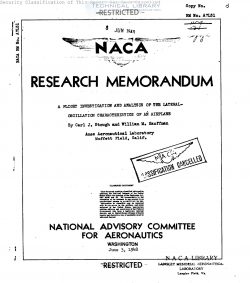naca-rm-a7l31
- Version
- 40 Downloads
- 1.33 MB File Size
- 1 File Count
- April 20, 2017 Create Date
- April 20, 2017 Last Updated
National Advisory Committee for Aeronautics, Research Memorandum - A Flight Investigation and Analysis of the Lateral Oscillation Characteristics of an Airplane

Flight tests were conducted and an analysis made to determine
the causes of undesirable dynamic lateral-stability characteristics
of an airplane. Various rudder modifications were flight tested
with the rudder free and fixed over an indicated airspeed range
from approximately 200 to 450 miles per hour. Rudder-hinge—mcment
and other pertinent data were obtained by flight and wind-tunnel
tests.
The oscillation period and time required to damp to one-half
amplitude measured in flight are compared with calculated curves
in which these characteristics are given as functions of the impor-
tant rudder hinge-moment parameters.
An analysis of the data showed that there were no significant
changes in the basic rudder-fixed stability derivatives with indi-
cated airspeed, and the rudder-fixed damping characteristics were
predictable with sufficient accuracy if the product-cf-inertia
terms were considered.
Freeing the rudder brought about a reduction in the damping
of the oscillation at low speed; this is attributed to the low
negative rate of change of rudder hinge-moment coefficient with
rudder deflection and a negative rate of change-of rudder hinge-
moment coefficient with angle of sideslip. The fUrther deteriora-
tion with indicated airspeed is attributable to the effects of
Mach number and rudder-tab deflection on these hinge-moment paranp '
eters.
A number of military airplanes recently have exhibited poor
lateral-oscillation characteristics in high-speed flight. The
objectionable motions of the airplane in yaw usually are charac-
terized by constant-amplitude oscillations or by poor damping in
conjunction with a short period. In an effort to determine the
causes of these phenomena, the Ames Aeronautical Laboratory has
conducted a detailed investigation of the dynamic lateral-stability
characteristics of an airplane for which undesirable oscillatory
behavior at high airspeeds had been reported.
| File | Action |
|---|---|
| naca-rm-a7l31 A Flight Investigation and Analysis of the Lateral Oscillation Characteristics of an Airplane.pdf | Download |

Comment On This Post